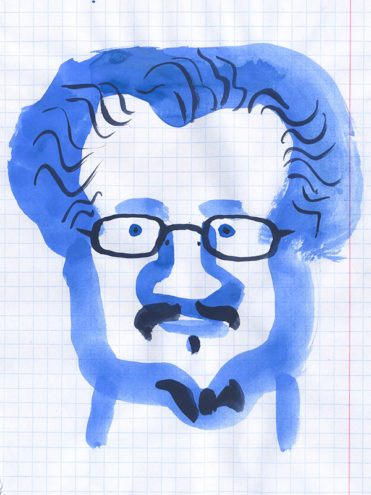 Antoni Rząsa’s Wood Anthropology
Antoni Rząsa’s Wood Anthropology
On the Basis of Several Sculptures
In the beginning there is a tree. From soil, water, air, and fire. As it grows up, it grows in, grown into the air and fire, the soil and the water. For us, who have come into existence later, trees grow towards the Sun, but for birds and angels it’s the other way around: trees grow towards Earth. The one who carved them, did not sign his work in any way; where would he put his mark? On the roots, the trunk, the boughs, or perhaps the leaves? A tree is like music. It does last longer than sounds, but the duration does not mean much, because if something is there, it is there always. It is there in all the times and tenses of its significance, its being. And in wood there is a tree.
We appeared in the world after the trees did, and in them, in their story, their destiny, we saw, we read, we found our fate revealed. We are so like them, from soil and water, air and fire. When saliva and mud drop from our eyes and we regain our sight, the first thing we begin to see are walking trees, that is, people. This miracle of seeing makes such hostile elements – birth and death – become one: a being. So it is in sculpture, or actually in all of Antoni Rząsa’s sculptures, but mainly the one which could be called “Destiny”. The carving is made of three items: the cross, Jesus in a crown of thorns and with an open heart, and an infant lying in a cradle. There is also a chain wrapped around Jesus’s heart and leading on to the cradle, to the baby. Unless perhaps it’s the other way around, and it was man who threw this chain around God’s heart? Or maybe it is like in the Bible, in prophet Jeremiah’s words: “O Lord, thou hast seduced me, and I was seduced; thou wert stronger than I and hast overcome me.”1God seduces man, but man also seduces God, because this is a matter of heart; the secret of happiness.
Antoni Rząsa did not name his sculptures. Why would he? Every title, every name tells lies in an attempt to enclose eternity. Our language, as everything else, is just starting to crawl. Tentatively, like a child, it stretches its legs, at the same time bending its arms, and instead of the head, it sticks its bottom out to the sky and the Sun. With this in mind, you could call one of Master Antoni’s earliest sculptures “The Very First”: not a chimpanzee, not a gorilla or a baboon; there’s a bit of each. The same thing happens in the sculptures representing people: there are slanted, Asian eyes, African lips and hair, a Nordic oval of the face. “The Very First” sits like a chimpanzee, hands by the ankles. The right hand is still apish, but the left is already human, as only man, ape not yet, can hold his hand like that, tightly, exactly, in a fist.
The face of the “The Very First” is human-and-ape-like. Yes, it is wooden, but also as if stony, made of flint. Most of all, it is both demonic and divine. A double-crowned brow: the crown of a king, or perhaps a jester, and then an aureole of thorns. Animal, man, God. Shapelessly shapely. Derived from wood, he remains unalienated. He rather grew out of, rolled out of a log, was created from it, and not carved.
The case is similar with the sculpture “Simultaneity”. The log it was made of first served Antoni Rząsa as a vice. The Master did not have too much work with “Simultaneity”: as much as a midwife with a case of regular labour. The difference was, he was simultaneously the woman having the baby and the one delivering it. He both gave birth and assisted. Like in the sculpture “Morning Joy”: a very young mother who is just spreading her wings, tiny still, is playing with her child. A light breeze lifts the mother’s apron. Laughter, twittering, babbling are bird’s song to her ear. Indeed, a little bird has perched on the mother’s ear. Time has chipped a bit off its wing, but then at the same time it confirms that it is not only man who creates the world.
Let us return to “Simultaneity”. To quote Czesław Miłosz, sculpture provides proof that our species has the courage to reach for the unattainable. At the ribs on the left side, the log cracks, parts, opens like a grotto, like lips, as if a womb. But not from its insides, not from the space guarded by its walls, does the man’s Radiant Head emerge, but from the chest, from the sternum that connects the ribs, and thus from the heart, from the most profound human depth. At the same time, the open side, live flesh, brings to mind a cave, the womb of Mother Earth that gives birth to people, just as it did to the Son of God. Above the radiant, crowned, pained face, we have the Other Face. A man’s, is it, or rather a woman’s? It is hard to say unambiguously. It is for sure a human’s. That human is giving birth to another. Living in the ecstasy of bringing to life he dies, and dying in the ecstasy of dying, he comes to life. Thus the sculpture invalidates, or at the least problematizes speech. We speak of life, we speak of death, yet we see the simultaneity of both taking place. The image is unclear, like a mirror reflection, like peering through a haze. But is it not enough if our eyes reach beyond the horizon of the word and the horizon of visibility? A sculpture speaks, it tells a story, but also awaits a word which would bring it to life, verbalize it.
The “Pietà of Empty Hands”: a woman; who knows if she is holding up the falling body of a man, or maybe lifting it from the ground, hoisting it up. She heaves it off the ground, puts it on its feet, raises upwards, to where the open-handed, stiff arms of the man who is dead, dying, coming to life, pierce through the blue firmament, bursting into heaven. In vain; their deathly stiffness, the numb fingers, reach emptiness. Heaven is empty. Heaven is not there. “My Lord, oh My Lord, why have you forsaken me?” There is air, there are clouds, stars, and thus other suns of other worlds. Other? Life is here, where the body of the man is entwined with that of the woman, the mother with the child, mother and son. The body is both divine and human. In the “Pietà of Empty Hands” the man’s body comes to life in the woman’s arms. It is she who gives him life, who revives him. And so Pietà, not pain, sorrow, grief, bewailing, despair, resignation and calm, or magnanimous devotion. No. All the time it is life, a lasting in elapse.
From among Antoni Rząsa’s sculptures, one does not need a name, because it has one simply due to the nature of things: “Francis of Assisi”. Francis’s face looks like straight from an Assisi fresco. A wreath of doves; a fluttering, dancing, cooing halo around his head, also from Francis’s Little Flowers. One of the flowers, as if a star, blossoms on the index finger of the saint’s right hand. On his left index there is a tiny cross. But there’s also a snake. Francis steps on its tail with his left foot; the tail, not the head. It could not be otherwise, because both he and the snake share the same fate, growing up to the fullness of life, that is, to happiness, to overdivination. Francis does not wish to, means not to defeat anyone or anything, win over, pin down, make them bite the dust, annihilate, but to save. With his left foot he holds the snake by the tail, and it, contrary to its nature, which does not allow it to stand vertically, straightens up, as befits one who has plenty to say about the ups and downs of the life both of people and angels, and also God, as well as the ups and downs of the life of world’s elements, trees, and animals.
There was a time when people hanged other people on a tree, a stake, a cross. A person was hanged on something. Recently people have started hanging others on nothing. By the hands, in the air. A group of “Three”, a triptych, represents three men in prison, camp, striped uniforms. Two of them have long hair, the head of the third is shaven bald. One has a double pair of hands; one pair are the hands of a doomed man, the other, with the fingers pointing to the ground, holds the wrists of the dying man. It looks like Someone from above put his hands on the wrists of the one hanging on a chain in the air. It is not clear whether it is the moment in which the Someone from above has just arrived and is grasping a man falling into death, or maybe it is the last moment, when the dying man slips out of the hands of Somebody who rushes to him with help. Maybe the hands will close and save the doomed man from death? But no, no miracle occurs. Still there is no miracle. The doomed man’s face confirms the conjecture. Then perhaps the dying man and the one saving from death are actually in one another, they are one inseparable entity. They are in a covenant, like God and man. There is no sense in asking which of the doomed is Jesus and which the villain. He is everyone and everyone is him. If anything, then the most perfect representation of Jesus is the man with the shaven head, because he is the least conformable with our visions of God.
Perhaps this is why Antoni Rząsa’s grave has been given a cross carved in the air. Not in wood, stone, iron, but in the air. The one who, carving, made the invisible visible, knew, knows, that a sculpture, like any work of art, is alive and tells about our dream of what’s impossible and therefore most beautiful: of happiness. No wonder that Master Antoni Rząsa did not fear the heart: a symbol, it might seem, so hackneyed. Just as he was not afraid to place in this very heart, as in a roadside shrine or a Gothic cathedral, a crimson spider. A symbol as well.

 The website was created with the financial support of the Zakopane City Hall
The website was created with the financial support of the Zakopane City Hall
 Rok Antoniego Rząsy dofinansowano ze środków Ministra Kultury i Dziedzictwa Narodowego pochodzących z Funduszu Promocji Kultury
Rok Antoniego Rząsy dofinansowano ze środków Ministra Kultury i Dziedzictwa Narodowego pochodzących z Funduszu Promocji Kultury